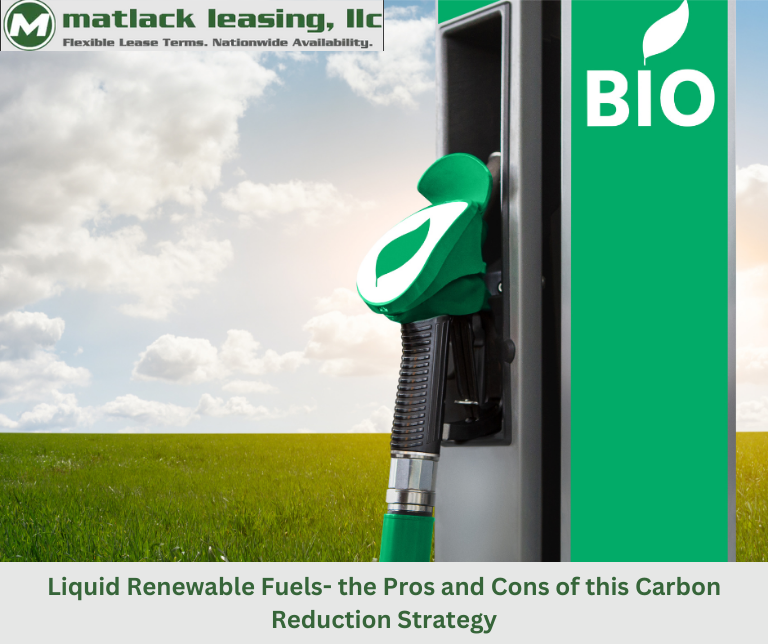Renewable Fuels are Important to Lower Greenhouse Gas Emissions Targets
Since the Energy Policy Act of 2005 and the Energy Independence and Security Act of 2007 were enacted, the US has become a leader in the development of renewable fuels. Renewable fuels produced from biomass sources are often called green or biofuels. The newest technologies are now producing such fuels through biological, thermal, and chemical processes.
While the movement to lower greenhouse gas emissions has been debated for years, we are currently amidst a proactive movement to develop alternative fuel sources to supplement and gradually move away from the use of carbon-based fossil fuels.
The push for renewable liquid fuels has undergone several phases in its development. The first phase was derived from various crops and animal fats, including ethanol and biodiesel as the main products developed in this phase. The US Department of Energy’s Alternative Fuels Data Center reports that there are more than 3,300 public E85 stations in 42 states for the 21 million flex-fuel vehicles that traverse America’s highways each year. The second generation of renewable fuels focused on cellulosic biofuels (those made from cellulose) and the third, most recent phase, features algae as a feedstock.
The effects of biofuel technology have been very promising in lowering greenhouse gas emissions. Research shows that the CO2 that biofuels emit is being recycled by the atmosphere. Researchers from the Massachusetts Institute of Technology (MIT) shared in their MIT Climate Portal that they see the potential in biofuels to be “carbon neutral” or possibly “carbon negative” in the near future, implying that automobiles and machinery using renewable fuels may remove as much CO2 as they put back into the atmosphere. There is great promise that renewable liquid fuels will continue to improve air quality and stall the rise in global temperatures mitigating additional damage to the environment.
What Are the Most Common Types of Renewable Liquid Fuels?
Renewable liquid fuels are made from biomass, such as plants, animal waste, and cooking fats. These biofuels are touted as replacements for petroleum fuels like gasoline and diesel. The three most common types of renewable hydrocarbon biofuels include:
- Renewable diesel – This is a biofuel that can be utilized in diesel-powered engines. According to the US Energy Administration, there are currently five plants producing renewable diesel in the United States, with California as the main consumer of renewable diesel fuel. The EPA reports that 960 million gallons were consumed in 2020 and demand for this biofuel is growing; production is expected to grow to 2 billion gallons.
- Sustainable aviation fuel (SAF) – SAF is produced from renewable resources and is currently being blended with conventional jet fuel to be used in aircraft. SAF is currently being used at the Los Angeles and San Francisco International Airports. There is currently only one facility domestically producing SAF, though plans for several more are forthcoming.
- Renewable gasoline – This is a biofuel similar to biodiesel. This ‘green’ gasoline is manufactured for use in spark-ignition engines. Currently, ethanol production is increasing in the US and is most prevalent in the midwest.
Pros and Cons of Liquid Renewable Fuels
Liquid renewable fuels are showing great promise for the future of fuel consumption. The biofuels that are currently being domestically produced are compatible with current engines and infrastructures, increase energy security, decrease emissions, and provide more flexibility than ever before. These biofuels are also providing positive economic advantages as new production facilities are built and existing manufacturing facilities grow.
However, there is concern over the ramifications of biofuel production. Resources used for producing biofuel feedstocks are often the same as those used for human consumption. Mass production of biofuels could result in higher food prices which have already seen recent dramatic increases. Also, the use of fertilizers and demand for feedstock could result in runoff transferring pollutants from air to water and harming other natural resources.
Sustainable Transport / Logistics
The outlook for sustainable transport of liquid renewable fuels is promising. Unlike petroleum, biofuels have not yet found their way into pipelines and rely on the trucking industry for transport. Also the distribution of biomass resources creates more demand for transportation. As more production facilities are being constructed and technology continues to develop, the demand for tank trailers appears to be on the verge of potential new growth.
As we continue to develop renewable fuel technologies, the demand for tank trailers is predicted to remain high. Because the Department of Energy and the EPA both cite major growth of biofuel production, take a proactive approach and contact Matlack Leasing, LLC at 1-800-MATLACK to discuss your tank trailer needs.
Sources
- “Economics of Biofuels.” EPA, Environmental Protection Agency, Accessed 19 October 2022.
- Prather, Krisala Jones. “Biofuel.” MIT Climate Portal. Accessed 19 October 2022.
- “Renewable Hydrocarbon Biofuels.” Alternative Fuels Data Center: Renewable Hydrocarbon Biofuels,. Accessed 17 October 2022.

